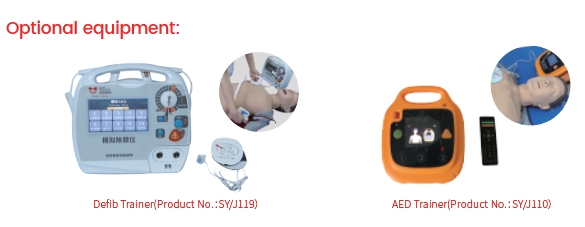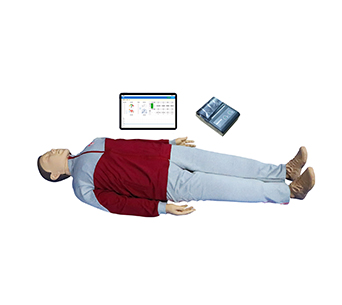
■ Simulate the accurate anatomical position of the human head and neck, with the head able to swing left and right and rotate horizontally 180 degrees, making it easy to remove oral foreign objects.
■ The eyeball adopts OLED simulation, with visible colored retina, black pupils, transparent crystals, and the ability to reflect light at any angle.
■ The carotid artery pulsation can be palpable, and in a state of death, the carotid artery pulsation disappears; The intensity of carotid artery pulsation has force feedback, and the greater the pressure on the finger, the stronger the pulse beating, which can be perceived as whether there is a checked pulse.
■ Implementation standard for cardiopulmonary resuscitation: 2020 American Heart Association CPR and Cardiovascular Emergency Guidelines, supine position with head tilted back.

■ Tablets can be connected by scanning QR codes or manually selecting the WIFI name for wireless connection
■ Equipped with a portable wireless Bluetooth thermal printer for printing transcripts.
■ It can interact with real defibrillators, simulated defibrillators, and simulated AEDs for defibrillation operations, display defibrillation energy values in real time, and record them in the transcript.
■ Editable CPR parameters, including CPR time, CPR cycle times, compression ventilation ratio, correct ratio of compression and blowing, standard range of tidal volume and compression depth, defibrillation energy interval value, etc., can be set with one click for national competition standards, and mentors can freely set according to teaching needs.
■ Detailed transcript statistics, including transcript name, name, student ID, time, mode, score, CPR standards, CPR time, number of cycles, CPR results, defibrillation results, compression and blowing data statistics, defibrillation statistics, waveform of each compression, waveform of each blowing, frequency of each compression, best performance and improvement suggestions.
■ The system is divided into four operation modes: specialized training, comprehensive training, comprehensive assessment, and practical assessment. Waveform charts and bar charts are used to display the depth and tidal volume of each press, and the frequency of each press is recorded in a marked point manner to visually display the specific situation of each press and blowing.
* Specialized training is divided into three methods: pressing only, blowing only, pressing and ventilation, and there are corresponding voice prompts, such as pressing too small, pressing too large, not rebounding, blowing too small, etc. After each method of training, the training transcript can be printed.
Electronic monitoring of multiple indicators throughout the process:
* Pressing section: Monitor the number of presses (excessive or insufficient), pressing position (correct or incorrect), pressing depth (too large or too small), pressing frequency (correct or incorrect), pressing rebound, and displaying pressing interruption time.
* Monitoring of Blowing Part: Blowing frequency (excessive or insufficient), tidal volume (excessive or insufficient), tidal time, and gas intake into the stomach.
■ According to the operating standards of the 2020 American Heart Association Guidelines for Cardiopulmonary Resuscitation and Cardiovascular First Aid, cardiopulmonary resuscitation operations can be evaluated, and the operation meets the standards, simulating human resurrection; The operation did not meet the standards, resulting in simulated human death.
■ Real time display of parameters such as pressing depth, pressing position, pressing frequency, tidal volume, tidal time, airway opening, and gas intake throughout the entire process.









